[Photographer Paul Diamond of Brooklyn, New York, born June 20, 1942, passed away on August 16, 2017 at the age of 75, after a short illness. Click here for a brief New York Times death notice; click here for a sample of Paul’s images in the collection of the Harvard Art Museums; click here for a sample of Paul’s images in the collection of the Smithsonian America Art Museum; click here for a sample of Paul’s images in the collection of the Art Institute of Chicago.
I don’t recall exactly when or where I first met Paul — somewhere in the small, fractious photo scene of the late 1960s in New York City. Our mutual friend, photographer Les Krims, tells me that Paul introduced him to me at the opening of Les’s November 1969 Witkin Gallery show, so Paul and I had connected some time previously.
Subsequently I reviewed Paul’s April 1974 solo show at the Floating Foundation of Photography for the New York Times, a review that I included in my 1979 collection of essays, Light Readings. I also included a portfolio of Paul’s images in my 1977 critical survey, The Grotesque in Photography, and I numbered among his recommenders for the Guggenheim Fellowship he received in 1975. I thought highly of his work then, still do, and believe he’s a seriously overlooked figure from that era.
Paul and I stayed in touch through the late 1980s, then lost contact — my fault, I’m sure. I hadn’t heard from or about him for years until Les emailed me about his death earlier this month. I attended the memorial gathering held at the Bushwick Community Darkroom in Brooklyn, New York on October 14, 2017 at 10 a.m., organized by Paul’s daughter Brooklyn Diamond Schnarr and his ex-wife Cynthia Diamond. This proved a particularly apt venue, reminiscent of the communal DIY environment of the New York photo scene half a century ago, when Paul and Les and I entered it.
Les had flown down from Buffalo with another of Paul’s friends and colleagues, Jim Sylvia, so we renewed acquaintances, told tales of the old days, and caught each other up on our lives since we’d last met. As we sat in a circle with members of Paul’s and Brooklyn’s and Cynthia’s family, trading stories about Paul, Les read a few passages from something he’d written about Paul. These caught Paul’s spirit so well that I asked Les for permission to publish them here. I’ve included a few photographs of Paul by Les, and a portrait of his mother by Paul, as illustrations. — A. D. C.]
•
My Friend Paul Diamond
I first met Paul in 1966. I saw this guy in a white T-shirt walking toward me on St James Place, directly across from Pratt Institute’s Brooklyn campus. When he got close, I saw there were small pieces of toilet paper on his face, each adhered with a dot of blood. I stopped him, pointed at the patches, and asked, What’s the problem? He explained that he’d sharpened his father’s straight razor, shaved, and nicked himself several times — the toilet tissue stopped the bleeding. It was the first time he’d used a straight razor.
We exchanged names. He mentioned seeing me at work in Pratt’s printmaking studio. He was an art student at Pratt, too. For the next 51 years, Paul was rarely clean-shaven.
•
Our friendship weathered divorces, multi-day sneezing fits brought on by cigarette smoke or any kind of animal dander, car accidents (including one where he drove his car into the rear of my new Porsche), debates about the best recipes for making coleslaw or candied orange rind, and how often to shower (Paul smelled like a broiled lamb chop after a few days without one).
Paul sent hundreds of letters to me over 51 years. All were written on graph paper, using a ballpoint, in his idiosyncratic style of Arrighi cursive running hand. He sent presents of cookbooks, knives, and meticulously painted balsa wood models of WWII Japanese Zeros (his favorite plane), many in uniquely engineered hand-made boxes laminated from corrugated cardboard and wood glue. In 1985, his wedding present to me was a reproduction of a Navy Colt Revolver. We worked together at Buffalo State College for a year, before Paul took off in his car on his first cross-country adventure.
•
My phone rang on a chilly March morning, in 1971. The caller identified himself as an FBI agent. He asked if I knew anything about the kidnapping of a teenager that happened the day before, in Memphis, TN. He said the kidnapper demanded that 6 photographs of mine be removed from a group exhibition at the Memphis Academy of Arts. The pictures were removed immediately, and the boy was released after being driven around for a few hours in a Volkswagen bug.
It was creepy news! I asked the agent if the kidnapper might be heading up to Buffalo after me? Doubtful, he said. I called Paul, to tell him what had happened. (Paul lived two blocks away for the year he taught at BSC.) A few minutes later, Paul showed up carrying a baseball bat, and stood guard for two days.
•
Over the years, Paul collaborated with me to help make numerous photographs — some of my favorites … He enjoyed modeling. We had a 50-year-long conversation about photography’s evolution, craft, and odd politics. Neither of us had formally studied photography. We taught each other.
Once he drove from Indiana to Buffalo, just to show me a fiberglass “tub” he made to develop large RC paper prints in his apartment. He was a graduate student at Purdue University, studying for an M.A. degree. The school’s photo lab could not accommodate the scale of prints he wanted to enlarge, and his flamboyant expression and ambition as an artist was, I’d guess, difficult to abide in a conservative academic environment.
Before heading back to Indiana with his “canoe” (that’s what he called the tub), we made a picture. I cut a large stencil of a Star of David, and used it to spray-paint a pattern of the Mogen Davids covering the driver’s side of his gray 1963 122S Volvo wagon, from headlight to taillight. He posed standing on top of his car, with a 3-pound Hebrew National salami hanging from a belt cinched around his waist. He was naked, except for burlap booties and my ritual phylacteries (tefillin) attached to his head and arm. I’d used them studying for my Bar Mitzvah. He told me that he’d never had a Bar Mitzvah, and we decided that when the first negative was exposed we’d say in unison, “Today I am a man!” as the flash popped. (The picture’s title: “The Wandering Jew and His Jew Mobile.”)
Years later, his daughter, Brooklyn, would use the same phylacteries while studying for her Bat Mitzvah.
•
Paul’s friend and mine, Jim Sylvia, threw an extravagant Thanksgiving party, in Buffalo, annually, for years. Dozens of friends and family were invited to what was a multi-day, multi-meal, extravagant, and unforgettable party.
Paul was always invited. He decided to drive to Buffalo at night, a couple of days before Thanksgiving. He hadn’t slept before leaving Brooklyn, and dozed off while driving just beyond Batavia, NY. His Volvo literally wrapped itself around a tree. Hurt, he was transported to the trauma center at ECMC hospital, in Buffalo. The hospital called me to say he was there.
When I got to his room, he was alert, resting, bruised, and missing six of his front teeth. He joked about the missing teeth, smiling to display the new gap. His doctor told me that aside from his teeth, and a bruised chest, he was strong as an ox.
Two days later, Paul was at Jim’s party, hard at work grating 10 pounds of potatoes, by hand, to make potato latkes, which he continually fried for the crowd, without a break, all afternoon. Another year, Paul prepared gallons of scratch-made chocolate pudding, and hand-whisked large stainless-steel bowls full of whipped cream. Paul always contributed a bottle or two of very expensive cognac, which he loved. Generosity, tenacity, physical strength, dependability, great warmth and affection, were a few attributes of Paul’s noble character.
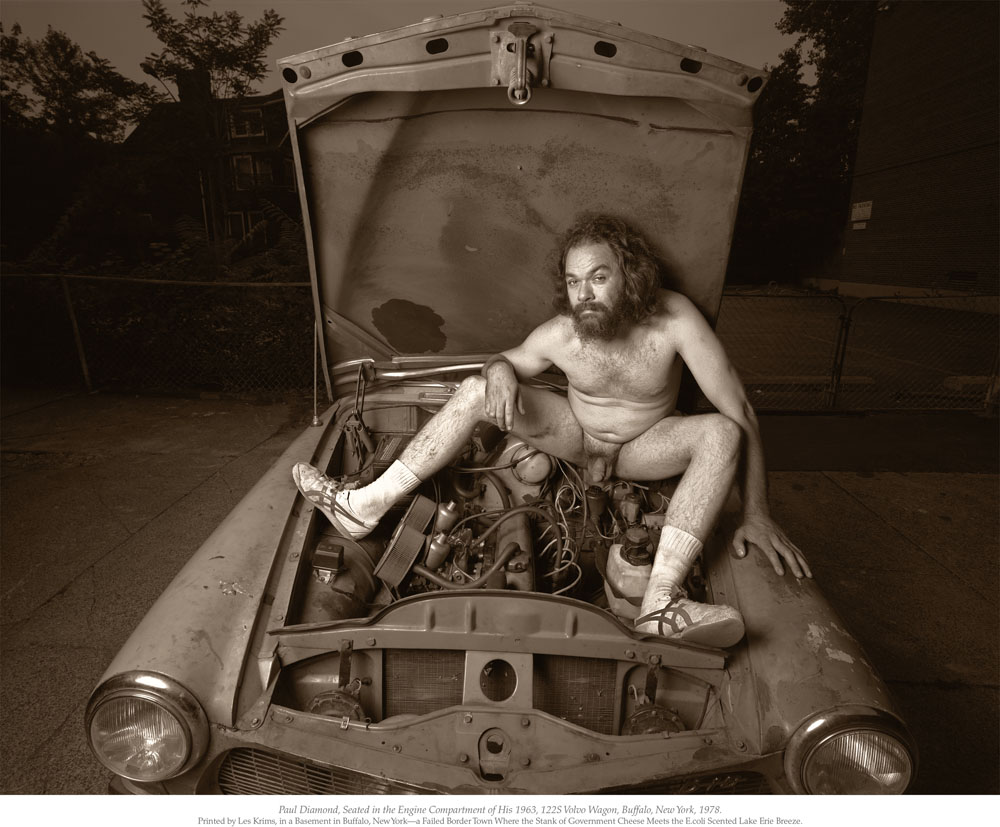
Les Krims,
“Paul Diamond seated in the engine compartment of his 1963, 122S Volvo Wagon,” Buffalo, New York, 1978
•
When our daughter was young, our family occasionally rented a house and vacationed for a few weeks on Martha’s Vineyard. An assortment of my wife’s family members would always show up, and to not be outnumbered, I’d invite Paul to visit.
On one visit, Paul told me he’d never been fishing. I loved to fish. So I took him to a little beach on Chappaquiddick Island, directly across from the loading point for the Chappy Ferry, in Edgartown. I knew fish could be caught there all day long with light tackle and a bit of squid. I showed Paul how to cast and use a spinning reel, caught a couple of fish to demonstrate the process, and handed the rod to him to try his luck.
On his first cast a fish instantly hit. I coached as he reeled in what turned out to be a large porgy. Paul grabbed the furiously wriggling, slippery fish to remove the hook. It lurched sharply in his hand, spitting the hook. Startled, Paul jerked his hand; the hook caught Paul’s finger and set deep. “Let’s go to Vineyard Haven Hospital, get the hook removed, and get you a tetanus shot,” I said.
Paul shook his head, emphatically grunting: “No!” He reached into one of his pockets, pulled out one of his razor-sharp knives (he carried 3 or 4 knives at all times, in the large pockets of his military-surplus cargo pants), opened its blade with a flick of his thumb, positioned its point above the hook, then cut into his finger and excised the hook. He looked at me and said, “Done! Let’s have lunch.”
— Les Krims
Buffalo, NY
October 17, 2017
•
Leslie Robert (Les) Krims (born August 16, 1942) is a conceptualist photographer living in Buffalo, New York. He is noted for his carefully arranged fabricated photographs (called “fictions”), various candid series, a satirical edge, dark humor, and long-standing criticism of what he describes as leftist twaddle.
Krims has published numerous offset works. Two of these, Fictcryptokrimsographs and Making Chicken Soup, were published by Humpy Press, which he founded and incorporated in the mid-1970s (it has since been dissolved). Krims has also published original-print portfolios such as “Idiosyncratic Pictures” and “Porsche Rainbows.” Most recently (November 2005), a Photo Poche monograph, Les Krims, edited by Robert Delpire, with an introduction by Bernard Noel, was published by Actes Sud, in France.
Krims has also steadily been adding pictures to an overarching project spanning three decades called “The Decline of the Left.”
In 2004, he had a two-month exhibition at Laurence Miller Gallery in NYC titled “Fictions 1969-1974.” In 2007, he had a retrospective at Galerie Baudoin Lebon in Paris. He has taken part in over a dozen group exhibitions of photography in the years 2000-2017, with others planned.
A selection of Krims’s pictures appear at his website, leskrims.com, through which he can be contacted.


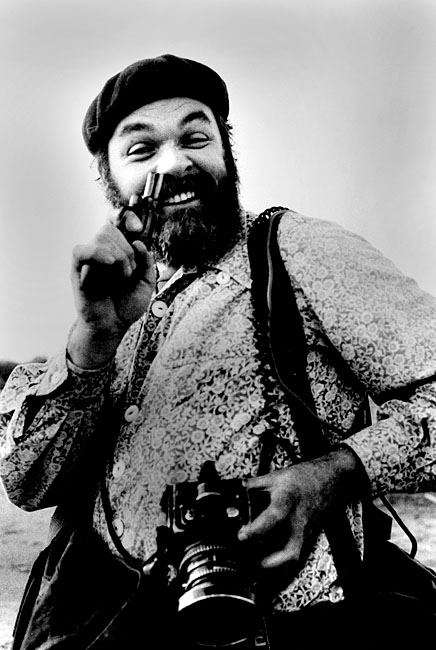
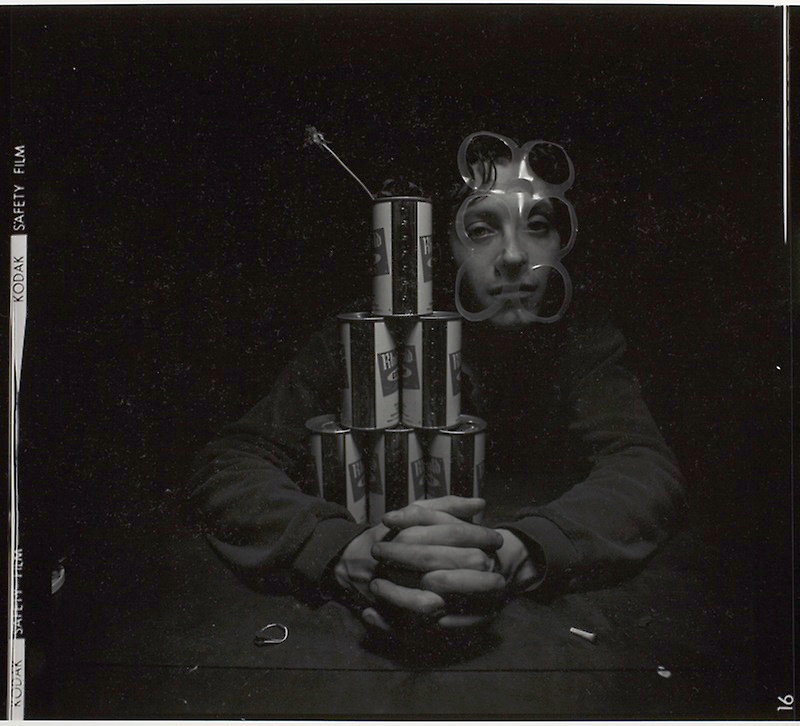
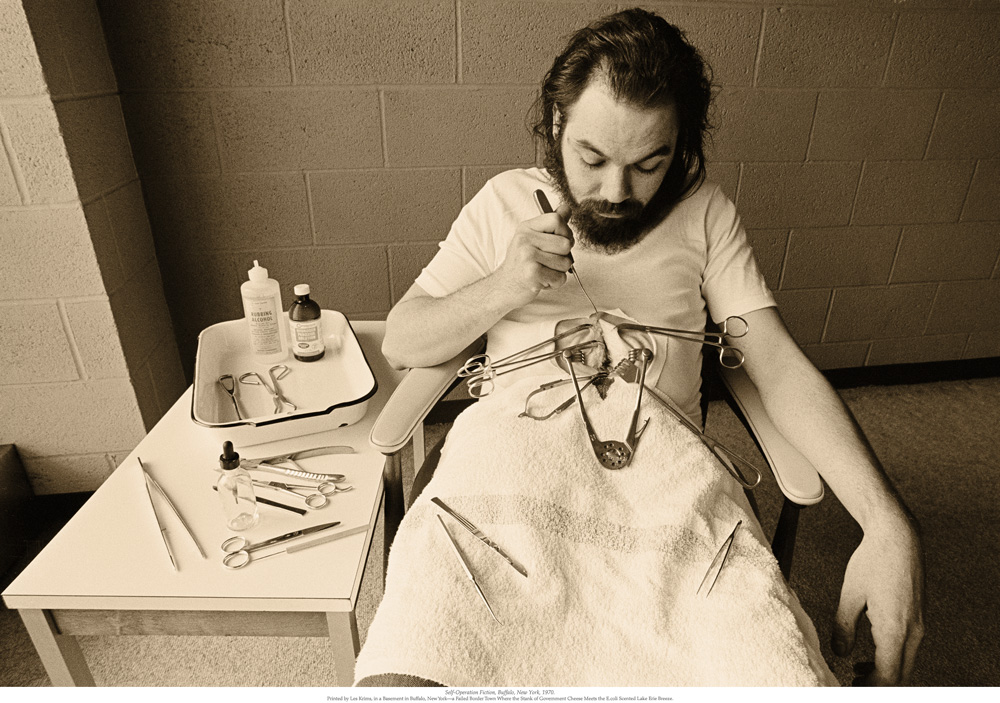
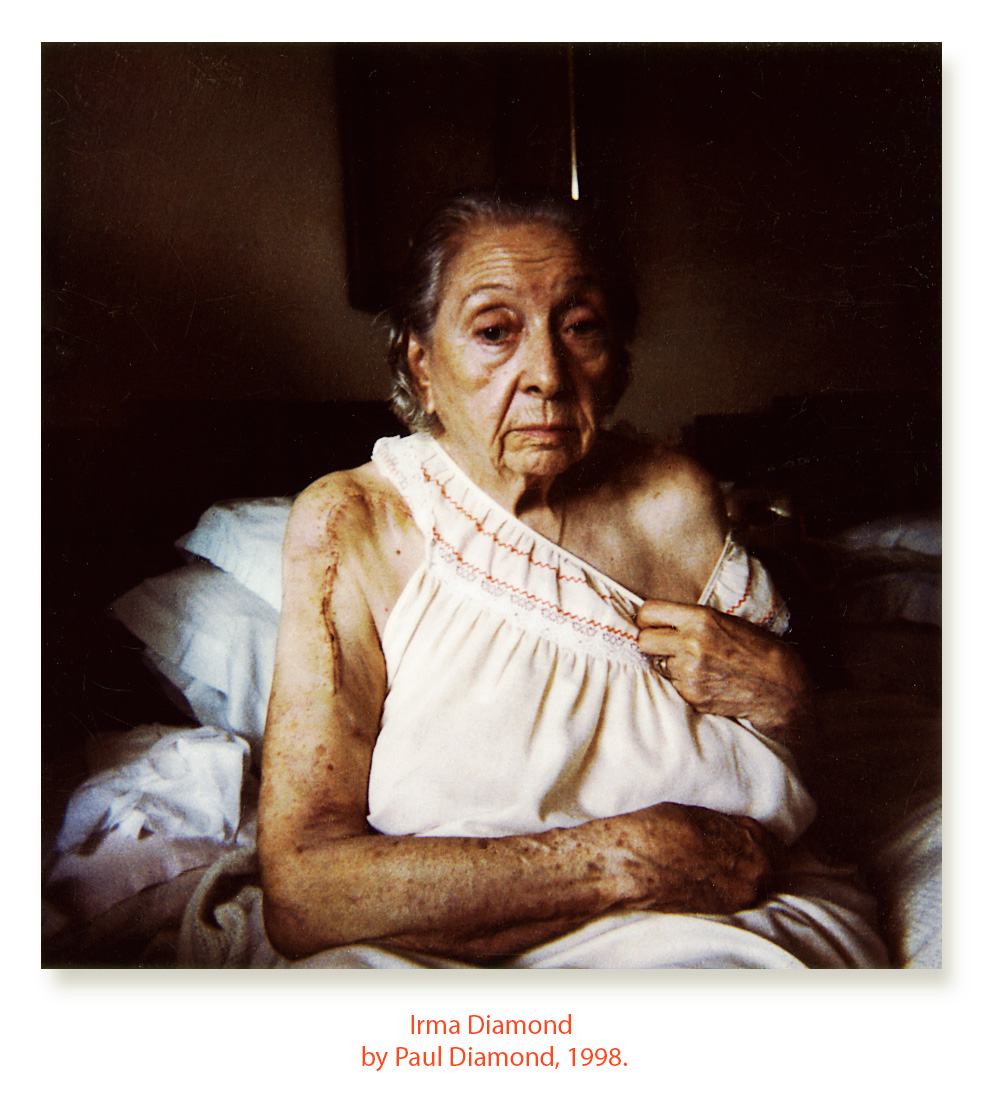
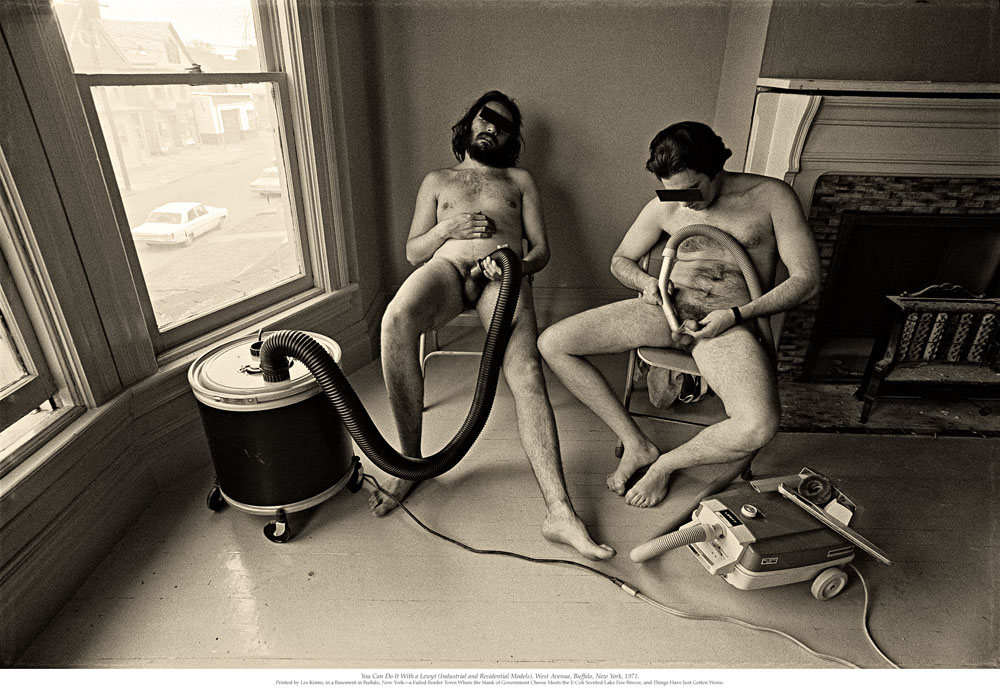
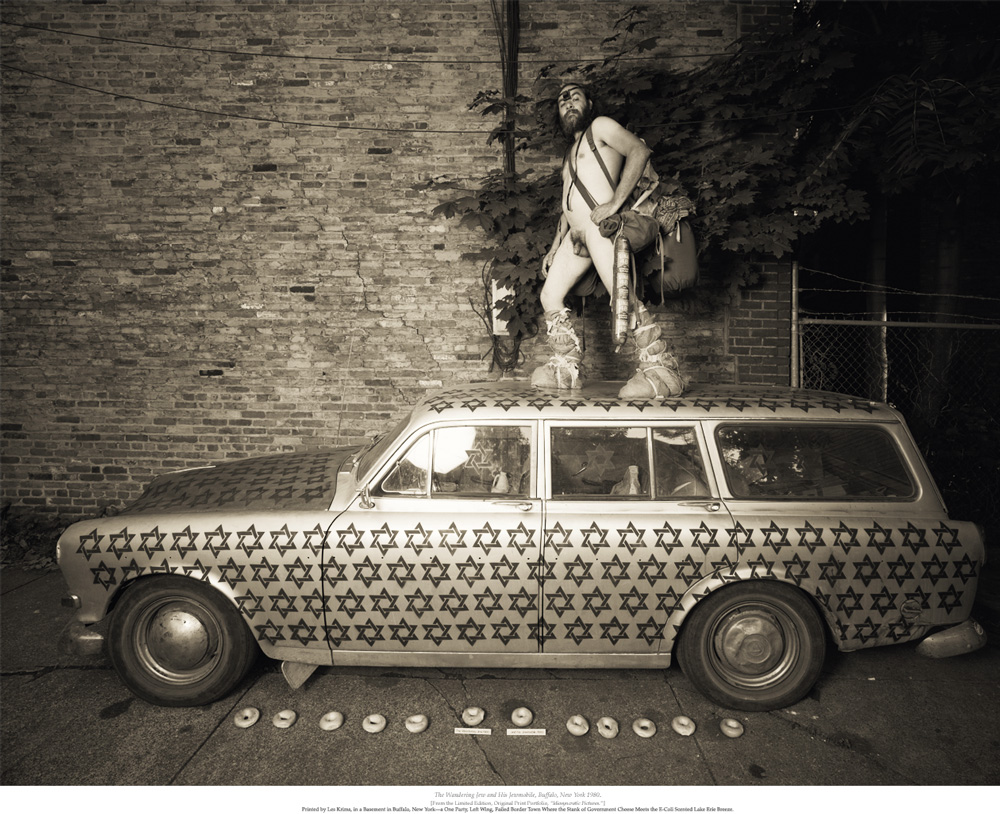
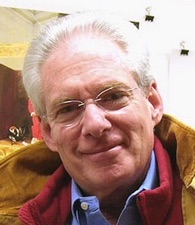




I have fond memories of Paul Diamond. We photographed each other at the “Market Diner Bash” in 1972 and then got together sometime after that to trade the photographs. (I’ll now go back into my photo box from ’72 to find the photos.) I can see his smiling warm face in the center of the group portrait taken by Neil Slavin that is posted on the Nearbycafe website. I remember wondering back in the 70’s what such a flamboyant person would do for a living with photography. If anyone can tell me, please do so.
Note: the Market Diner Bash was a unique photography community get together/party, organized by A.D. Coleman and Neal Slavin held at a diner on the west side of Manhattan.
Harry
Although I knew Paul off and on from various Society of Photographic Education conferences in the 1970s, and the Market Diner Bash of 1972, my most vivid impression was a period of five days that he, Les, Allan and I spent after a week at Asilomar for SPE 1980. I had spent a year preparing the Technology Track of eight presentations on things like holography, video and so on.
Following the conference in Pacific Grove we four retired to San Francisco where we did nothing but drink, smoke, eat and laugh non-stop, careening around the Bay Area from an Oakland base.
Paul was a street photographer who did much more. But, his ‘flash-in-your-face’ capture style was what Hunter Thompson would call gonzo. Sort of Weegee meets Frankenstein. The energy was palpable. The enthusiasm and joy was there, but it always had a tone of seriousness too.
Haven’t seen him in probably two decades, but I’m glad I got to know him back in those days.
I met him years ago in Montreal early 1980’s. I never forgot him and his photographs. The years are flying by, my condolences to his family. He was a very special person and highly overlooked artist . Thank you Paul x
Nice memorial A.D.
What is the backstory on this one?
https://www.harvardartmuseums.org/collections/object/285581?position=5
Yes, the years are flying by. I hope the photogs of the golden age of photography (1970s) will leave some detailed documentation of that era. One day…you will be gone. Then it will be too late then to have your say. It is sad, but so much of art photography revolves around $. If no $ is to be made, the photog wont do it.
Les Krims had send me a fascinating short piece he had written documenting some of the golden era, when he was first starting out, etc.
Get it all down, document everything, ephemera, etc. and put it on the Internet Archive, Open Library or Archive.is. If you can get into an institution interested in your life’s work, place your archives with a special collection library or art museum library. Websites are no good. As soon as the yearly bill stops getting paid it all disappears.
Personally, I’ve used the shotgun approach of spreading my archives all over the world. (130+ institutions) One institution can have a screw-up and you’re gone. I’ve already lost over 2 decades of work in a flood. I am very sensitive losses now.
Here is something I wrote on the importance of preserving ephemera.
https://danieldteolijrarchivalcollection.wordpress.com/2017/09/18/ephemera-an-often-overlooked-area-of-preservation/
I never thought much about ephemera until recently. A couple years ago a curator asked me for any ephemera of mine I could spare. I would usually just trash it when I was done with a project. After that I paid a little more attention to its importance.
I don’t remember the story behind that particular picture, though Paul probably told it to me way back when. Maybe someone else does. To the best of my knowledge, Paul didn’t keep notes on such things, or a diary. However, as Les Krims mentions, he wrote a stream of letters to various people, myself included, so the answer may be in one of those.
Thanks for the commentaries on ephemera. I think some of this blog’s readers will find those of interest.
A really terrific article about Paul, who as you noted is one of the more under appreciated photographers of the 70-80’s. Something not mentioned but Paul did receive a number of award for his work, if I am not mistaken, he got a Guggenheim as you noted but also an NEA grant and a NY CAPS grant all within a fairly short period of time. I first met Paul when I was a first year MFA student at CalArts in 1975, Paul was passing thru and was invited to do a lecture to the photo grads. He came into the room and covered the walls floor to ceiling with 16-20 prints, all pretty spectacular but very much in his style. We started asking him questions about the work and he pretty much refused to get very specific and was pretty cagie about his answers and I went home remaking to my wife, “What a jerk we had in seminar today, really a pretentious ass”, that weekend my own mentor Bart Parker who was teaching for one year at UCLA called me and said lets go photographing this weekend, there is a friend of mine you need to meet, it was of course Paul and after a day of photographing with him, he had won me over with his charm, wit and..well Paulness. We stayed friends for years and there are lots more stories to tell, it seems everyone who came in contact with him came away with a great story. His work still holds up today as powerful and insightful work. A unique talent if there ever was one and one I am proud to have known.
Thanks for this reminiscence.
I’m surprised that Paul struck you initially as “cagey” or otherwise reticent. I never got to see him at work in a classroom setting, as either a guest or a teacher, but he struck me as consistently forthright about his work, and loquacious to boot. Not boastful in any sense, but excited about his pictures, excited about the process of their making (including the situations from which they emerged), and more than happy to talk about all that.
Perhaps it was that he was speaking to a bunch of CalArts MFAs. I would agree with you that on a personal level, that Paul was as you described him, but at CalArts that day he didn’t seem to want to offer a real answer about any aspects of his work. I had the chance to show him my work years later and work with him at a summer seminar on Martha’s Vineyard (that I think you were part of ) and he was thoughtful and very generous about speaking to my work and his.
Dear Paul
I was deeply affected by the news of your passing. I will always be in your debt. I remember fondly our semester together in San Francisco/Berkely in 1975. I particularly remember the curries you made and the night we went out together and dared the staff to make us a curry that was so hot we couldn’t eat it. We sent (I think) two lots as being “wimpy” and by the 3rd attempt came we sat down to polish it off. Half the kitchen staff came out into the restaurant to watch us wolf it down with relish. They couldn’t believe their eyes. Mainly however, the feedback you gave me to help me with my work was always honest, forthright, considerate, thoughtful and invariably helpful and correct. I will carry those conversations (often going through the night to sunrise) in my heart forever. Farewell mate. I love you.
This was a great tribute to a photographer whose work I admired and discovered in your book Light Readings but had lost track of. I love the idea of creating a book on the photographic luminaries of the mid to late 70’s…such a rich time.
Also curious what path Paul followed in the 90’s and 2000’s?
Thanks again for all of this.
In my final semester at the University of Colorado in 1977, Paul arrived as a visiting artist and taught a studio class. I wasn’t quite prepared for his out-sized personality but he was unforgettable and the memories of him are good ones. Our final gathering was held at his favorite Asian restaurant. He ordered plates of fabulous, fiery food for all of us, then took a group portrait.
He had always stressed that he gave copies to his subjects, but we both left Colorado and I lost touch with him. Then a few years later he arrived for an exhibit in San Diego, where I was living at the time. The portrait was on display and he walked right up to me, pointing and saying, “I have a copy for you, but I don’t have the money for shipping.” He gave me his address and I sent him a check for $20. He cashed it but I never got the print, which I thought hilarious.
I never doubted his intent and sincerity; life sometimes diverts us from our intentions. I’ve kept the cancelled check as a memento, hanging it over my flat files. Over the years I tried to find out any news of him and was sad to belatedly learn of his death. He is indeed an underrated artist.
Thanks for sharing this anecdote. In my experience, Paul had a number of fine qualities, among them intense loyalty and keeping his word. If that print never arrived, I suspect that he lost your address once he cashed the check. Somewhere in his materials there’s probably a print with your name on it …
Just remembered him today when I composed a perfect image in the frame, just like I remember him teaching me to remember to do when I was his student at CCAC, Oakland CA, 1977? sorry to know he is gone. Quite an extraordinary human, as I recall.
Paul, my wife, jillian Denby, and I were in the same class at Pratt. We all spent a lot of time together in the print shops and hanging out. Paul and I both were bicycle lovers. We often would go out at 1 in the morning and bike over the bridge onto Manhattan. I remember Paul was always sharpening some knife or wood block tool. I think he had worked for Leonard Baskin keeping his tools sharp. Paul was living at home with his mother right across Willoughby Ave from Pratt. We lived in the next building and would go over and hang out with her and Paul and a few other close friends. I remember how happy she was to meet Paul’s friends and be included. We say him a few times after graduation but lost track as everyone dispersed around the world. He was a genuine character – one of a kind.
For several years after I separated from my first wife, I lived in Alphabet City, at 229 E. 4th St. Periodically, Paul would phone to find out if I was home and then bike over the bridge, always bringing food with him — baklava and flatbreads with za’atar and meat pies and olives from the Middle Eastern shops on Atlantic Avenue, or take-out from Chinatown, or something he’d made himself (he was big on spicy black beans). Plus a six-pack or two. We would fire up a doobie, chow down, drink beer, and make photos — he always brought along his camera and related equipment. I have prints of half a dozen portraits he made of me in that space … some of the best pictures of me anyone ever made.
Hi love your writings – may i ask how to contact les Krims? i have his early prints too – i m friends w/ Micheal Martone -Thx so much _Like your page alot
hope to see your lectures soon
It has been a long long time since I have been in touch with Paul. I am so sad and actually stunned to find out today that he has died. I spent much time with him in 1978 when he was teaching, and I was his student, at Ca. College of Arts and Crafts (now Ca. College of the Arts). His generous loving and outrageous spirit made everything fun. He lived at a level of intensity that most people cannot even imagine. I could not keep up with him though I tried. He gifted me with photos and drawings and many notes. I treaure them all. I loved Paul then and I still do. I wish I could tell him that, again.
I am so sorry to learn of Paul’s passing. I had been looking for him several times on the internet over the years. I was an art student at Buffalo State when he came to teach there. I was introduced to him by Les Krims, my photography instructor. Well, we began dating and generally hanging out together. He was so funny, spontaneous and charming. I was smitten.
He took me to a concert to hear The Mothers of Invention at Kleinhans Music Hall. Of course he had his camera and tri-pod along. And although we had seats towards the back he boldly went right up in front of the stage and began photographing Frank Zappa and the band. (It was the early 70’s security was nonexistent). After a few minutes Aynsley Dunbar, the drummer spotted Paul and leaned down from the stage and asked Paul to come backstage after the concert, he was interested in getting Paul’s info and seeing the photos.
Well, we went backstage and Paul took a bunch of candid shots of the band and he even included me. He took a picture of myself with Frank Zappa and later presented me with a 16×20 glossy black and white of it. I cherished it. But somehow over the years and many moves it slipped away from me. I’ve thought about Paul and that photo so many times over the years. A friend of mine who dated Jim Sylvia (Paul’s close friend in Buffalo) told me Paul kept all his negatives. And I thought perhaps he might still have that infamous one of me and Frank.
If anyone out there is reading this and knows if there is a chance for that photo to still be around, I would love to know.
I loved reading all these Paul stories and I was glad to have known him. My condolences to his family❤️.
Dear Mr Coleman,
I just found out your blog and I m totally thankful about it. I m so happy that one can still find serious art and photography criticism online.
I also just found out about this talented photographer and epic figure who was also your friend, Paul Diamond. I ll look him up online. I m sorry for your loss, and I m also sorry for not having lived in the US in the seventies. Seems like it was the best time ever for a photographer.
Also I d like to thank Les Krims for the great, humane, moving text on your late friend.
Glad you found this blog and enjoy it. Thanks for your condolences and good words.
I think it’s always a good time to be a photographer.